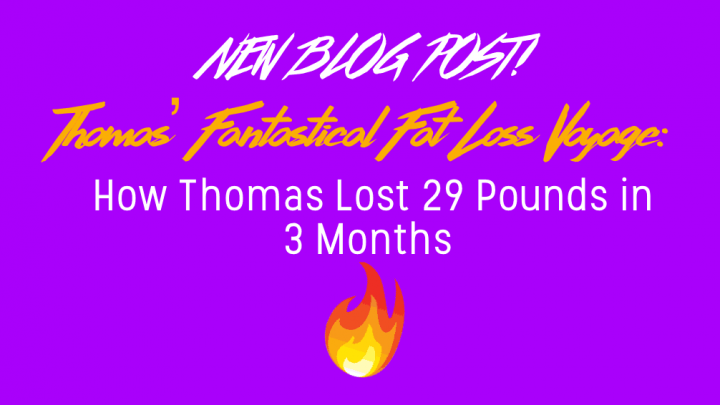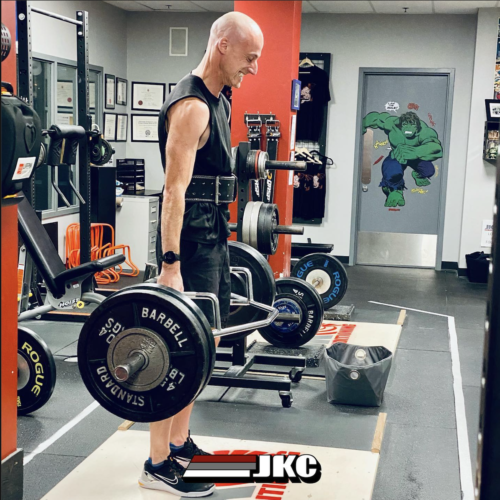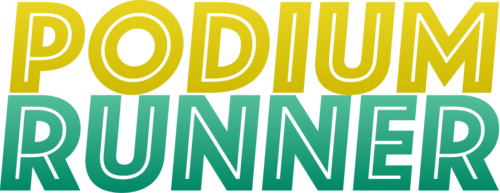
Many of our clients have been asking me about my weight loss so we thought it best to write this post so everyone can learn more about the program I followed. If you have any follow-up questions though, do not hesitate to ask. We also have a nutritionist working with us now, so you can ask more detailed questions about the type of program that’s right for you!
Before: January 6, 2019
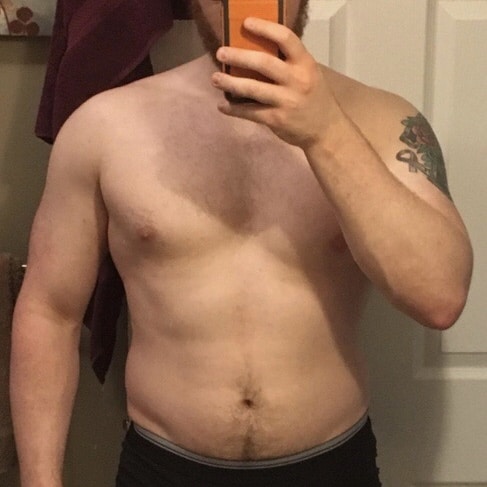
After: April 6, 2019

The Results in Detail
In the table below, you can see that I lost a total of 29 pounds over a 3-month time period. What’s also important though, is that I still managed to maintain muscle mass while cutting my calorie intake.
| Measurement | January 6 2019 | April 7 2019 | Total Lost |
| Body Weight | 224.4 Pounds | 195.2 Pounds | 29.2 Pounds |
| Shoulders | 51.50” | 50.75” | 0.75” |
| Chest | 45.00” | 42.25” | 2.75” |
| Waist | 38.00” | 31.75” | 6.25” |
| Hips | 43.00” | 39.5” | 3.5” |
| Thigh | 26.00” | 24.25” | 1.75” |
Looking at these numbers tells me that I achieved my goal of maintaining muscle as the largest inch losses were waist and hips, two of the most common fat storage regions. While I did lose some width on the chest measure, I suspect that it was mostly fat from the back, another common fat storage area. As seen too, the shoulder measure decreased very little as it is not a common fat storage area, again suggesting that I maintained a fair amount of lean body mass while still losing fat.
It’s important to note that, if you neglect to keep your protein intake high while decreasing your overall calorie intake, this can lead to a loss of muscle, a decrease in strength, and a decrease in metabolic rate. So let’s see exactly how I achieved my results!
The 5:2 Diet
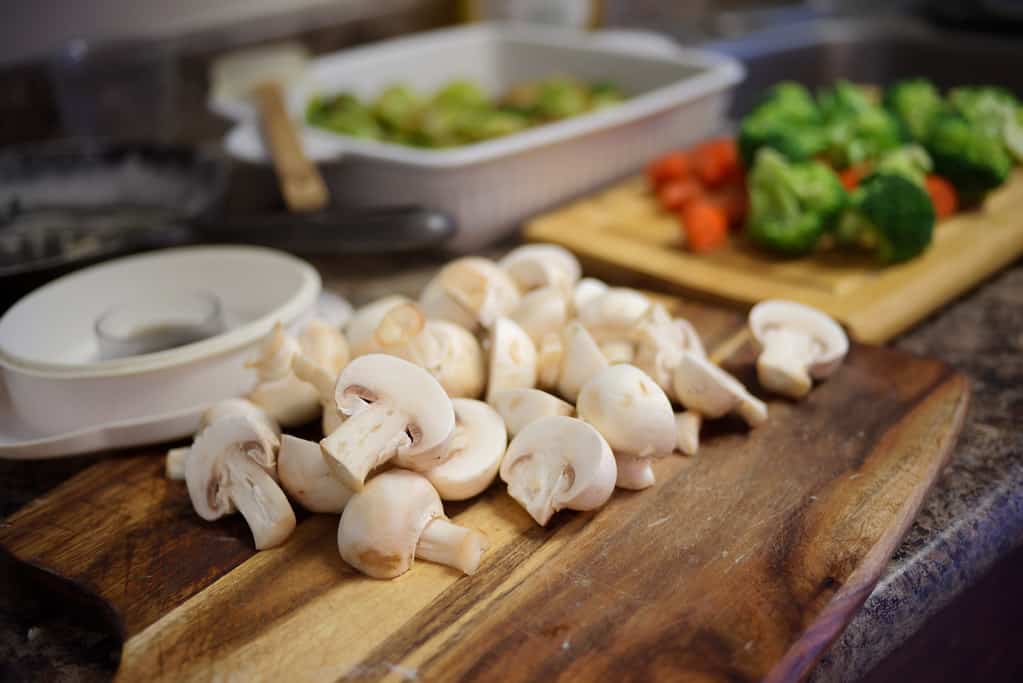
The 5:2 diet is a form of intermittent fasting. In simple terms, you eat normally for 5 days of the week and on 2 non-consecutive days, you “fast”. The reason I put fast in quotation marks is because it is not a true fast, you actually eat 2 small meals 12 hours apart. For me, the two meals were 400 calories each, the original diet suggests 400 for males and 300 each for females.
My Typical Fasted Day
BREAKFAST (6:00 am): 400 Calories
SUPPER (6:00 pm): 400 Calories
So what’s in these 2 small meals? It’s totally up to you! However, you should fill them with nutritious, satiating (filling) foods that are high in protein. For me, breakfast was often the following:
- 2 protein muffins (My own recipe): 120 calories each
- 250 grams of Icelandic yogurt: 160 Calories
- 75 grams of mixed berries: 30 Calories
For supper, I often ate just meat and veggies, something like this:
- 200 grams of lean ground beef (cooked measurement): 350 Calories
- 1 cup of mixed frozen peppers and onions: 50 Calories
- Garlic powder, salt, chilli powder, and balsamic vinegar, to taste
Again, these meals were high in protein to help keep me full and avoid a loss of muscle mass. Of course, you do not need to follow my meal plan, just try to make sure that the foods you are eating a both nutritious and filling. Avoid excess refined carbs on these days as they provide very little nutrition and do not keep you full.
My Typical Normal Day
On the other five days, you can just eat normally. This is not a license to overindulge all day on junk foods, I still ate well on my “normal” days. I would suggest that you eat at a “maintenance level” calorie intake, that is, the amount your body requires to neither increase nor decrease in weight.
To get a rough estimate of your maintenance level of calories, multiply your body weight by 14 and set your daily totals at this amount. For example:
195 Pounds x 14 Calories/Pound = 2730 calories/Day
You can eat whatever you would like on these days, but ensure you eat lots of protein, healthy fats (e.g., omega-3 fatty acids), and more moderate amounts of high-fibre (unprocessed) carbs. And yes, for those who will ask, booze counts against your daily total.
Calorie contents of alcoholic beverages, for your reference:
- 1 Regular Beer = 150 Calories
- 1 Light Beer = 100 Calories
- 1 Glass of Wine (5oz) = 125 Calories
- 1 Mixed Drink (1oz) = 70 Calories, mixed with water or diet soda, up to 230 Calories mixed with regular soda
Weight Loss Plateaus
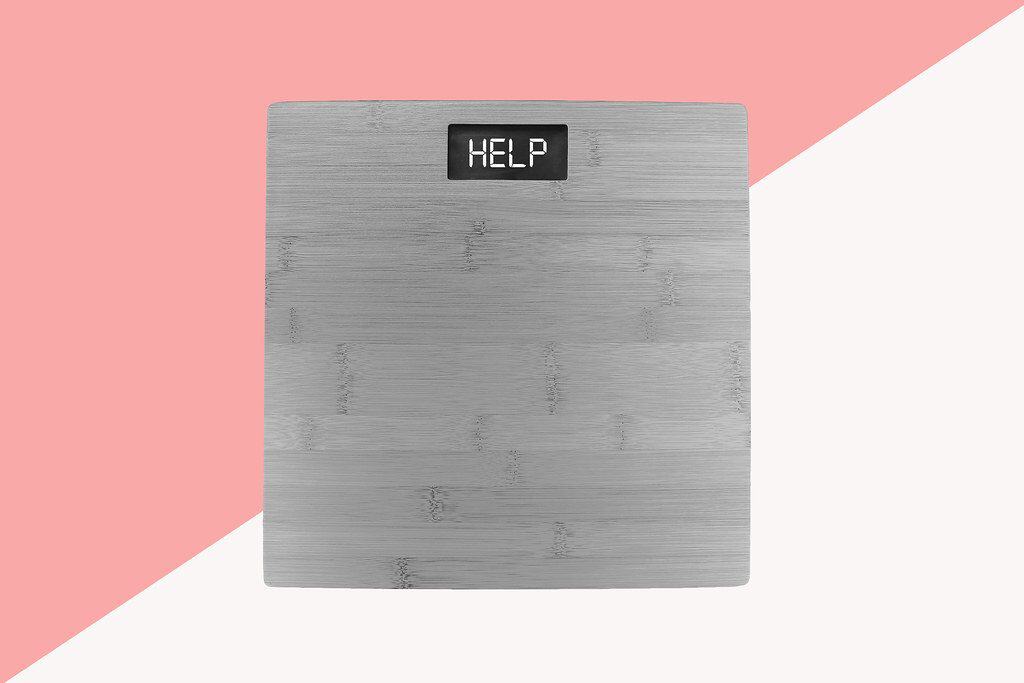
If you find you are still not losing weight, adjust this number downward but do not go below bodyweight x 10. Also note, as you lose weight, you may have to adjust this number to reflect your new maintenance. I readjusted my normal day calorie intake 4 times during the diet.
Let’s have a closer look at my typical normal day:
BREAKFAST (6:00 am)
- Oatmeal (1/2 cup)
- Protein Powder (1 scoop)
- Mixed Berries (1 cup)
- Whole eggs (2-3)
LUNCH (12:00)
- Rice/pasta (1 ½ cups measured cooked)
- Chicken/beef/pork/fish (250 gram Serving)
- Veggies (1-2 cups, can be frozen veggies)
SUPPER (5:00)
- Rice/pasta (1 ½ cups measured cooked)
- Chicken/beef/pork/fish (250 gram Serving)
- Veggies (1-2 cups, can be frozen veggies)
BEFORE BED SNACK (9:00)
- Cottage cheese (1 full tub)
- Blueberries (1 cup)
- Natural peanut butter (2 tablespoons)
The key here again is high protein to stay full and moderate amounts of carbs and fats. When you look at the lunch and supper I have just written meat and vegetables with rice or pasta. This was not just plain meat and pasta. This was often a stir fry or spaghetti or some other tasty recipe. I have no interest in eating just plain chicken and plain rice. Just be cautious that the “taste” you add limits added sugar and fats.
That pretty much wraps up what I did!
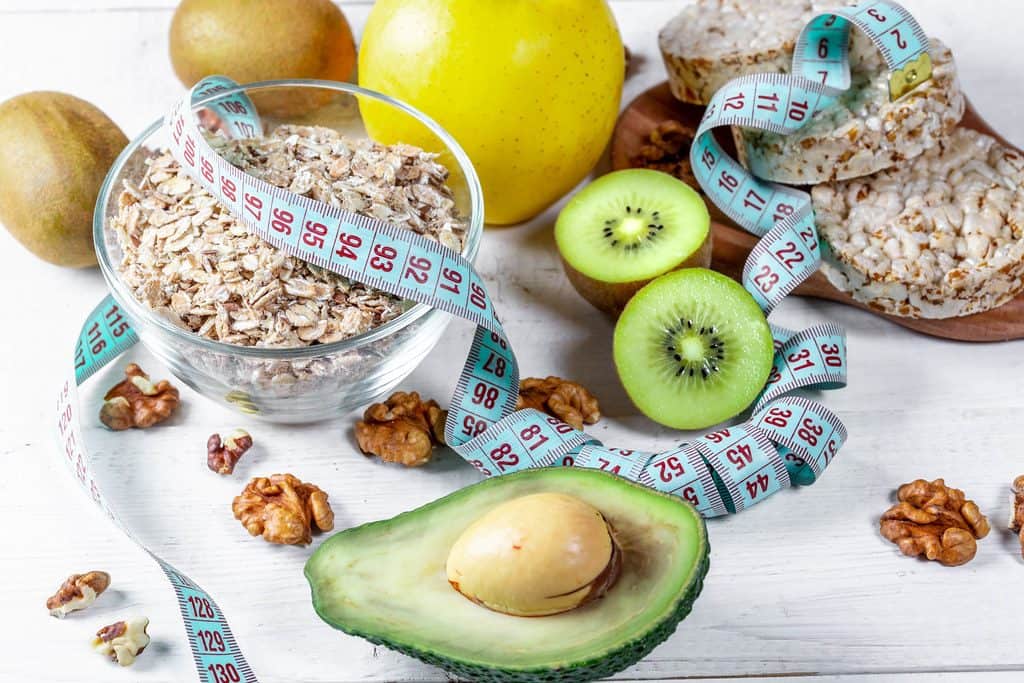
Thomas’ Favourite Fat Loss Tips and Tricks
In closing, here are some of my top tips and tricks:
1) Always know when and what your next meal will be! This is my number one tip. The main reason people snack on foods or make poor choices for meals is they do not have a plan. There is never a time when I don’t know what my next meal is. I make my weeks’ worth of lunches on the weekend, prepare my breakfast the evening before and plan out suppers for the week and buy groceries accordingly.
2) Follow the 90/10 rule. Essentially, 90% of your calories must come from nutritious sources while 10% can come from not so nutritious sources. I like to refer to this as bending without breaking. How often do you go out somewhere, have two drinks and maybe some chips and just assume the day is a total loss and have more drinks and more chips? Maybe those two drinks and handful of chips fit perfectly fine within the 90/10 rule. Don’t assume the whole day is a loss because of one cheat and sabotage yourself as a result.
3) Limit the availability of snacks when consuming alcohol. Alcohol lowers our inhibitions so that bag of chips you may not have touched earlier is far more likely to be eaten after a couple of drinks.
4) If you are going out somewhere and are worried about snacking, try to eat beforehand. This can even be just a protein shake, just something to keep you full. If you do want to snack, choose snacks with some nutritional value, for example: the shrimp platter is far more nutritious than the cookie plate. Many considerate hosts will also have some form of veggie/fruit platter to choose from.
Interested in JKConditioning’s Nutrition Coaching services? Find out more HERE.
Disclaimer: All content provided on this blog is for informational purposes only. The owner of this blog makes no representations as to the accuracy or completeness of any information on this site or found by following any link on this site. The owner will not be liable for any errors or omissions in this information nor for the availability of this information. The owner will not be liable for any losses, injuries, or damages from the display or use of this information. These terms and conditions of use are subject to change at any time and without notice.
photo credit: Kurayba Tasty Mushrooms via photopin (license)
photo credit: stockcatalog weight loss scale via photopin (license)
photo credit: wuestenigel Slimming and health food products on wooden background via photopin (license)
